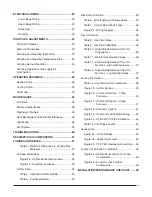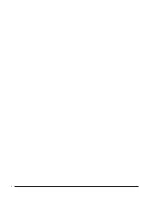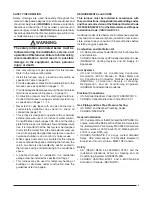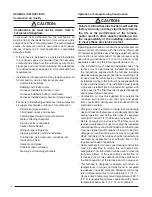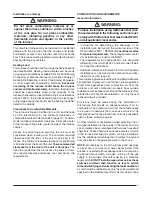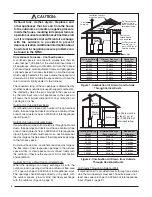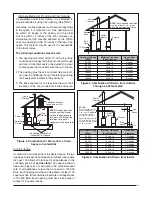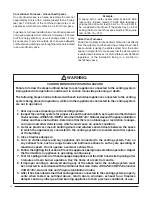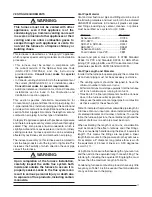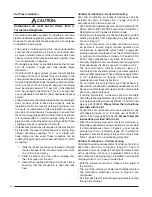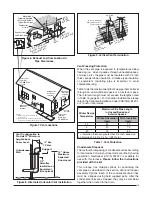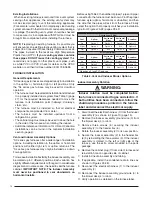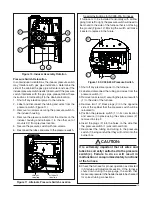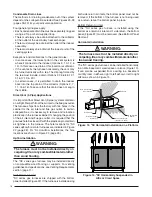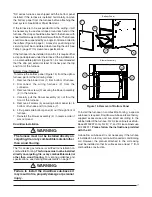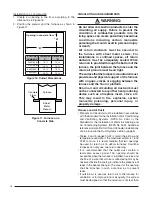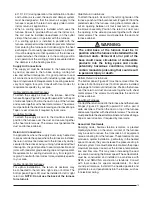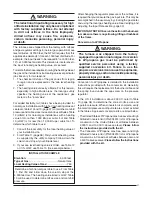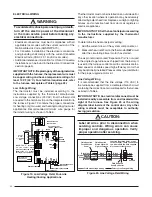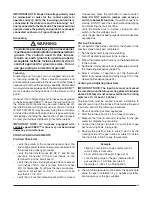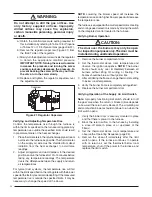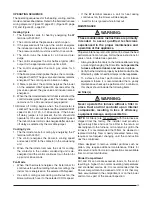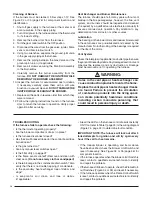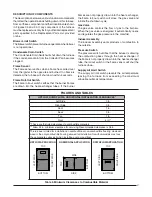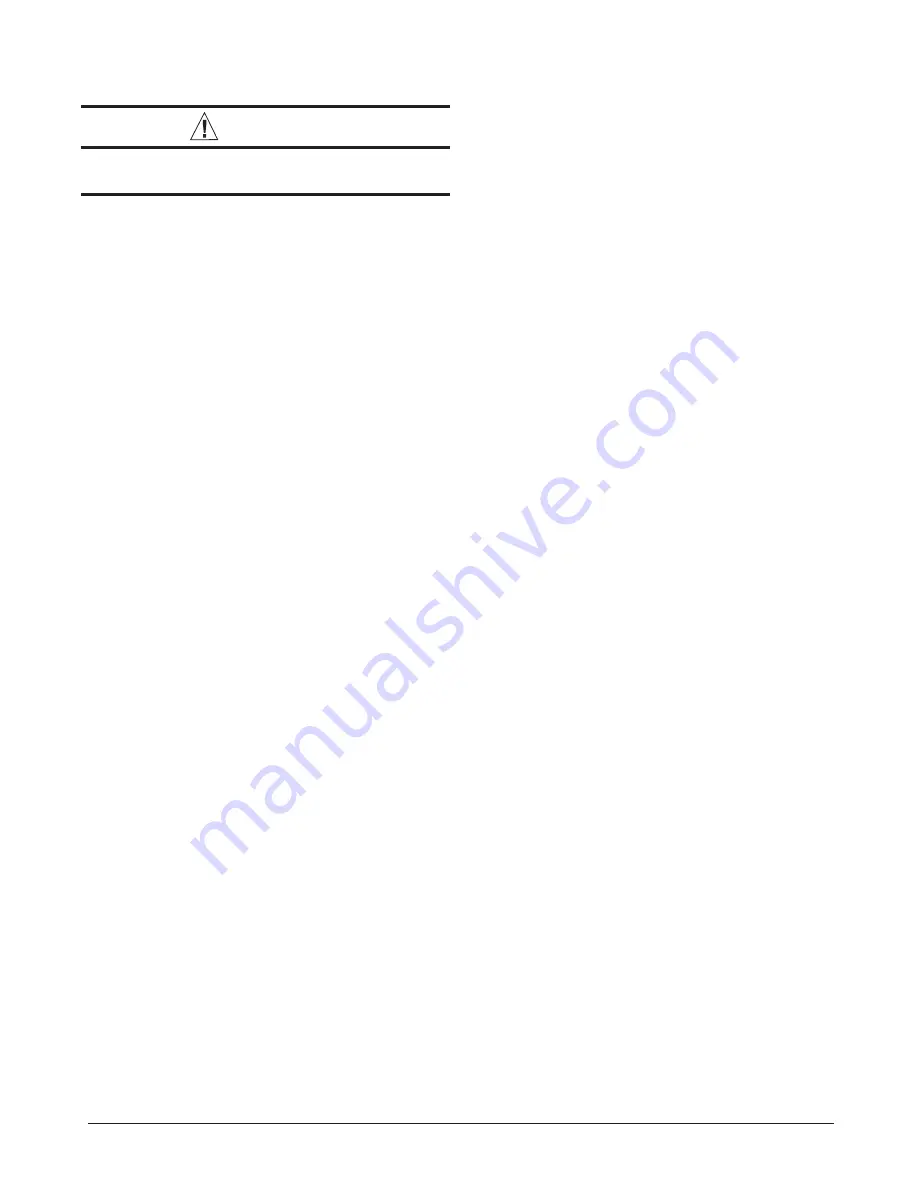
12
Vent Pipe Installation
CAUTION:
Combustion air must not be drawn from a
corrosive atmosphere.
This furnace has been certifi ed for installation with zero
clearance between vent piping and combustible surfaces.
However, it is good practice to allow space for convenience
in installation and service.
• The quality of outdoor air must also be considered. Be
sure that the combustion air intake is not located near
a source of solvent fumes or other chemicals which can
cause corrosion of the furnace combustion system. (See
list of substances on page 6).
• Route piping as direct as possible between the furnace
and the outdoors. Longer vent runs require larger
diameters.
• If a Direct Vent (2-pipe) system is used, the combustion
air intake and the vent exhaust must be located in the
same atmospheric pressure zone. This means both pipes
must exit the building through the same portion of exterior
wall or roof as shown in Figure 29, page 43. Vent piping
must be sloped upwards 1/4” per foot in the direction
from the furnace to the terminal. This is to ensure that
any condensate fl ows back to the condensate disposal
system.
• Piping must be mechanically supported so that its weight
does not bear on the furnace. Pipe supports must be
installed a minimum of every fi ve feet along the vent run
to ensure no displacement after installation. Supports
may be at shorter intervals if necessary to ensure that
there are no sagging sections that can trap condensate.
It is recommended to install couplings along the vent
pipe, on either side of the exterior wall (Figure 29). These
couplings may be required by local code.
• If breakable connections are required in the combustion
air inlet pipe (if present) and exhaust vent piping, then
straight neoprene couplings for 2” or 3” piping with
hose clamps can be used. These couplings can be
ordered through your local furnace distributor. To install
a coupling:
1. Slide the rubber coupling over the end of the pipe
that is attached to the furnace and secure it with
one of the hose clamps.
2. Slide the other end of the rubber coupling onto
the other pipe from the vent.
3. Secure the coupling with the second hose clamp,
ensuring that the connection is tight and leak
free.
Outdoor Terminations - Horizontal Venting
Vent and combustion air intake terminations shall be
installed as shown in Figures 6 & 7 (page 13) and in
accordance with these instructions:
• Vent termination clearances must be consistent with the
NFGC, ANSI 2223.1/NFPA 54 and/or the CSA B149.1,
Natural Gas and Propane Installation Code.
• All minimum clearances must be maintained to protect
building materials from degradation by fl ue gases as
shown in Figure 7.
• Vent and combustion air intake terminations must
be located to ensure proper furnace operation and
conformance to applicable codes. Table 14 (page 38)
lists the necessary distances from the vent termination
to windows and building air intakes. In Canada, CSA
B149.1 takes precedence over these instructions.
• For optimal performance, vent the furnace through a wall
that experiences the least exposure to winter winds.
• The vent termination shall be located at least 3 ft.
horizontally from any electric meter, gas meter, regulator
and any relief equipment. These distances apply ONLY
to U.S. installations. In Canada, CSA B149.1 takes
precedence over these instructions.
• Do not install the vent terminal such that exhaust is
directed into window wells, stairwells, under decks or into
alcoves or similar recessed areas, and do not terminate
above any public walkways.
• If venting horizontally, a side wall vent kit is available
according to the pipe diameter size of the installation. For
2 inch pipe use side wall vent kit #904617, and for 3 inch
pipe use kit #904349.
Please follow the instructions
provided with the kit.
• Concentric vent termination kits are available for use
with these furnaces. For 2 Inch pipe use kit #904177
and for 3 inch pipe use kit # 904176.
Please follow the
instructions provided with the kit.
• When the vent pipe must exit an exterior wall close to
the grade or expected snow level where it is not possible
to obtain clearances shown in Figure 6, a riser may be
provided as shown in Figure 8 (page 13). Insulation is
required to prevent freezing of this section of pipe. See
Table 1 (page 13) for vent freezing protection.
Outdoor Terminations - Vertical Venting
Termination spacing requirements from the roof and from
each other are shown in Figure 9 (page 13). The roof
penetration must be properly fl ashed and waterproofed
with a plumbing roof boot or equivalent fl ashing. Vent
and combustion air piping may be installed in an existing
chimney which is not in use provided that:
• Both the exhaust vent and air intake run the length of
the chimney.
• The top of the chimney is sealed and weatherproofed.
• The termination clearances shown in Figure 9 are
maintained.
• No other gas fi red or fuel-burning equipment is vented
through the chimney.



